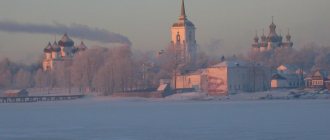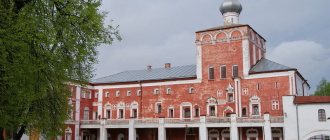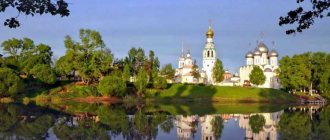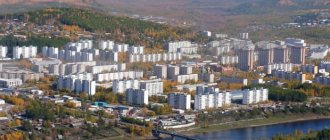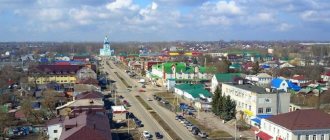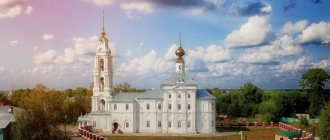View of the Alexander Nevsky Church, bell tower and St. Sophia Cathedral
Vologda is a city in Russia, the administrative, cultural and scientific center of the Vologda region, the center of the Vologda region, which it is not included in, having the status of a city of regional significance and forming the urban district municipal entity "City of Vologda".
Located 450 km from Moscow. The population of the city is 312,686 people. (2016). Together with the subordinate rural settlement of Molochnoye, within the boundaries of the urban district, the population is 320,605 people. (2016). The most important transport hub in North-West Russia.
It is one of the cities that have a particularly valuable historical heritage: 224 historical, architectural, and cultural monuments have been identified on the city’s territory; 128 of them are taken under state protection. Vologda is one of the largest cities in northwestern Russia.
Versions of the origin of the name
The main version concerns the Finno-Ugric origin of this word. It was first put forward by Finnish philologists Joseph Julius Mikkola and Jalo Kalima at the beginning of the 20th century, and domestic philologist Yu. I. Chaikina is also inclined towards the same theory. According to this version, the word “Vologda” is of Vepsian origin. The ancient Vepsian valgeda (modern vauged - white), with the usual transmission of -al- between consonants through Russian -olo- in the past, led to the formation of the word “Vologda” - a river with white (transparent, clean) water. But a more ancient origin is also possible: other Finno-Ugric names of the Dvina basin are known for -egda, -ogda (Vychegda, Kerogda) and names with the stem vol- (Volonga, Voloma, Voluga, Volokhtoma), which does not allow us to consider the name completely understood .
Versions of Slavic origin of the name are most often associated with its origin from the word “volok”. However, this version does not have serious support in science and is presented mainly in journalism and fiction, in particular in the work of V. A. Gilyarovsky “My Wanderings”.
Saint Sophia Cathedral
Address: st. Sergeya Orlova, 15B
This is the oldest stone building in Vologda, the construction of which in the style of the Moscow Assumption Cathedral began under Ivan the Terrible and lasted two decades. There is a legend that a brick fell on the king from the dome of the temple and he, angry, ordered the construction to be stopped. The temple was completed after the death of Ivan the Terrible.
During the Soviet period, it remained unharmed and was given over to house the exhibitions of the local history museum. In addition, the cathedral received the status of a historical monument.
Now, after several fairly large-scale reconstructions, the cathedral is in good condition. Inside it is a large area of 400 sq. m. there is a unique fresco depicting the Last Judgment.
Date of foundation
Monument to St. Gerasim of Vologda,
1147. This is the official date, first introduced into scientific circulation in 1780 by A. A. Zasetsky and based on the “Tale of the Miracles of Gerasim of Vologda” (1666) and the Chronicler of Ivan Slobodsky (1716). They say that in 1147 Gerasim of Vologda (monk of the Kyiv Glushetsky monastery, devastated during Batu’s invasion) founded the Trinity Monastery near the Vologda River. This marked the beginning of the city.
However, this evidence, which presents Vologda as the same age as Moscow, is currently debatable. Data from archaeological excavations date the city’s establishment no earlier than the 13th century. Many historians also consider the sources themselves, on the basis of which the foundation of the city is dated 1147, to be quite dubious. Both “The Tale of the Miracles of Gerasim of Vologda” and the Chronicler of Ivan Slobodsky date back to the 17th-18th centuries and did not have sufficient data about the biography of the saint.
In addition, there was no practice of monastic construction in the Russian North and North-East in the 12th century: the first monastery in Vladimir was founded in 1152, in Rostov - in 1212, in the Belozersky Territory - in 1251. Supporters of the founding of Vologda in 1147, in turn, point out that a detailed analysis of the “Tale of the Miracles of Gerasim of Vologda” and the Chronicler Ivan Slobodsky (including errors in copying from earlier sources) allows us to conclude that many facts in these sources are reliable and that Vologda still existed in 1147, only not as a city, but as a small settlement (and most likely not in the place where the historical part of the city was).
1264 This is the date of the first mention of Vologda in written sources: in the “finishings” of Novgorod with the Grand Duke, the Vologda volost is named in the list of other outlying possessions of Novgorod. In addition, the version of the founding of Vologda no earlier than 1264 is based on the results of archaeological excavations, which, as already mentioned, do not reveal Vologda before the 13th century.
Today, the only generally accepted fact is that the founding site of the city of Vologda was not its current central part, but the area around the Lazy site, where the Church of the Resurrection of Christ on the Lazy Market was located. This place was the center of the ancient city until 1565. Moreover, until this time there was not a single stone building in Vologda: all city fortifications, bridges, dwellings, churches, commercial and industrial premises were built of wood.
When is it celebrated, is it a holiday?
Many Russian cities timed celebrations dedicated to City Day to coincide with Russia Day - June 12. But the Vologda administration has set a floating date for the celebrations - the last weekend of June. If the state determines a long working week, then the holiday is moved to Sunday. In 2019, Vologda Day will take place on Saturday, June 29. The city will celebrate the 872nd year of its founding.
Rice. 1. Vologda residents at a youth concert
City status
The advantageous position of Vologda at the crossroads of waterways made the city in the 13th-15th centuries the object of internecine wars between Novgorod, the Tver and Moscow princes. In 1368, Moscow prince Dmitry Donskoy captured Vologda, forcing Novgorod to agree to joint ownership. For some time, two governors ruled in Vologda at once - Novgorod and Moscow. In 1371, Dimitri Prilutsky founded the Spaso-Prilutsky Monastery, three kilometers from Vologda, the first communal monastery in the Russian North. The construction of the monastery was supported by Dmitry Donskoy, who considered it as an outpost of the Moscow principality in the struggle with Novgorod for establishment in the northern lands.
In 1397, Moscow Prince Vasily I annexed Vologda to his domains, thereby putting an end to the joint administration of the city by Moscow and Novgorod governors. However, even after this, the city was repeatedly attacked by the Novgorodians, and was one of the objects of struggle during the Civil War of 1425-1453. As a result of the defeat by Dmitry Shemyaka, in 1446 Vasily II the Dark was exiled to Vologda, to whom the city was given as an inheritance. From here Vasily II went to the Kirillo-Belozersky Monastery, where Abbot Tryphon in 1447 freed him from the kiss of the cross in order not to claim the Moscow throne, after which the prince again continued the fight with Dmitry Shemyaka. In 1450, Vologda was besieged by the troops of Dmitry Shemyaka, who, however, were unable to take the city. After the death of Vasily II, Vologda in 1462 passed into the inheritance of his son Andrei the Lesser and became the center of the Vologda appanage principality. In 1481, after the death of Prince Andrei, who left no heirs, Vologda, as an escheat, passed to Grand Duke Ivan III and was finally assigned to the Principality of Moscow.
Sokol is not small by the standards of the Vologda region
The third place on the list is occupied by the small town of Sokol with a population of 37,192. Sokol is developing thanks to industry: pulp and paper and woodworking.
Since 2010, the settlement has been included in the list of single-industry towns, and funds have been allocated for the development of Sokol’s traditional industry. However, government assistance did not produce the desired results: the number of residents, which has been steadily falling since 1996, continued its steady downward path. Over the past 20 years, the number of city residents has decreased by almost 10,000.
The city during the time of Ivan IV the Terrible
Vologda Kremlin on a Dutch engraving (1675)
During the reign of Tsar Ivan IV the Terrible, Vologda became one of the most important transit centers in Russia's foreign trade with England, Holland and other Western countries along the North Dvina route and in trade with Siberia along the Sukhona and Vychegda. In the city, the sovereign's storage yard was built on the river bank.
In 1553, Vologda was visited by the English navigator Richard Chancellor, who in the same year established diplomatic relations between Russia and England.
In 1554, trade agent John Gass reported to English merchants about Vologda as a large city with an abundance of grain, where goods were half the price of Moscow and Novgorod, and there was no city in Russia that did not trade with Vologda. Based on the reports of J. Gass, in 1555 the British opened their trading office in the city, and the first Russian ambassador sent to England for negotiations was a native of Vologda, Osip Nepeya. In 1565, Ivan the Terrible introduced the Oprichnina and included Vologda in the oprichnina lands. In the same year, he visits the city for the first time and decides to turn it into the center of the Oprichnina and thereby into the capital of the oprichnina state. The Tsar ordered the construction of a new fortress, which it was decided to build in another part of the city, bounded on one side by the river, and on the other by the boundaries of the modern streets of Leningradskaya, Oktyabrskaya and Mira, along which the fortress moat was supposed to run. The laying of the fortress began in the personal presence of the king on April 28, 1566, the day of the holy apostles Jason (Nason) and Sosipater. In this regard, the territory of the fortress, located in a new place from the historical part of Vologda, received the name “Nason-city”. Another name for Nason-city is the Vologda Kremlin (now, in the minds of modern residents of the city, the Vologda Kremlin is not called the former territory of the fortress, but only the Bishop’s Courtyard).
Schematic plan of the Vologda Kremlin. Reconstruction by N.V. Falin.
In 1568, on the territory of the fortress, construction began on a new cathedral and the first stone building of Vologda - St. Sophia Cathedral, the construction of which continued until 1570 and was carried out according to the model of the Assumption Cathedral of the Moscow Kremlin. Thus, Ivan the Terrible gave his northern residence a metropolitan appearance. The construction work, carried out by the architect Razmysl Petrov, took place under the personal supervision of the tsar, who repeatedly and for a long time stayed in Vologda.
In 1571, Vologda became the center of the Vologda-Perm diocese, which was formed back in 1492 with a see in the distant Perm village of Ust-Vym. Thus, along with the trade and military-political rise, Vologda also strengthened in church affairs.
However, in 1571, Ivan the Terrible suddenly stopped construction work in Vologda and left it forever. Perhaps this was due to the tsar’s decision to abolish the Oprichnina, and, consequently, its supposed center. However, legend says that during his next visit to the St. Sophia Cathedral, a stone (or a piece of plaster) fell from its roof onto Ivan the Terrible’s head. The superstitious king, who received a serious head injury, took this as a bad sign and decided to leave the city. This legend is confirmed by the fact that the St. Sophia Cathedral, which Ivan the Terrible even wanted to dismantle, was never consecrated during his reign. The consecration of the cathedral itself took place only under his son Fyodor Ioannovich in 1587. And sections of the unfinished fortress, which were later briefly strengthened with wooden walls later in the 17th century, stood until the beginning of the 19th century, when they were dismantled by city authorities and local residents as material for stone construction.
Resurrection Cathedral
Address: st. Sergei Orlova, building 3.
This monument of Russian architecture, which is under federal protection, is part of the architectural complex of the Kremlin. Before this, another cathedral was located here. The current building, which has preserved its original appearance to this day, was erected in 1776 from the stones of one of the Kremlin towers. The decoration inside the cathedral was created in the 19th century.
City in "Time of Troubles"
The time of troubles for Vologda began with a plague epidemic in 1605 that swept through the entire city. In 1608, in conditions when part of the country was controlled by Tsar Vasily Shuisky, and part by False Dmitry II, the Vologda residents swore allegiance to the impostor. Owning Vologda, he not only gained control over Russian and English trading warehouses, but also could subjugate the entire north of the country. However, the new administration sent here with abuses and limitless extortions caused extreme discontent among the population, as a result of which Vologda moved away from the “Tushinsky Thief”. And in February 1609, a people’s militia under the leadership of Nikita Vysheslavtsev came out from Vologda to fight against False Dmitry II, liberating Romanov and Yaroslavl from the interventionists and their allies. In 1612, Vologda residents provided serious food and military assistance to the militia of K. Minin and D. Pozharsky. However, having sent huge military forces to support the second militia, there was practically no sufficient military contingent left in the city itself to protect it. As a result, on September 22, 1612, one of the Polish-Lithuanian robber detachments easily captured Vologda, after which the city was burned, and many residents were killed or captured. As Vologda Archbishop Sylvester testified:
| “the destroyers of the Orthodox faith came to Vologda in unknown exile, took the city, flogged all sorts of people, desecrated the churches of God, burned the city and suburbs to the ground.” |
Ecology and climate of Vologda
The land of white nights; Vologda owes this marvel to the influence of the northern seas. The distance to St. Petersburg (Baltiyskoye) is 660 kilometers, to Arkhangelsk (Severnoye) - 800 kilometers. According to science, this is called a “temperate continental climate zone,” but more simply, it is a long winter with sharp temperature changes - from -15 to -5 within a day and back, and a short hot summer.
Winter Vologda
The level of air pollution in the city is prohibitive. The main blame is placed on motor transport. Mountain statistics The administration recorded 103,563 units of equipment at the end of 2011 (excluding passing vehicles). Or, more than 1 car for a family of 3 people. According to environmentalists, vehicles account for 80% of all emissions into the atmosphere. This is an objective fact, which is hardly possible to change.
There is something that depends on the management of enterprises. The largest stationary sources of pollution are fuel and energy companies - MUP Vologdagorteploset, the Main Directorate of JSC TGC-2 for the Vologda Region (Vologda Thermal Power Plant), the construction industry - JSC Agrostroykonstruktsiya, the machine-building complex - JSC Vologda Optical-Mechanical. As a result of their intense work activity, the maximum permissible concentration of substances of humic origin in surface waters is greatly exceeded.
Smoke from thermal power plant
The main ingredients that pollute the Vologda River are substances, the increased content of which is determined by natural factors: copper, zinc, iron, COD. The anthropogenic component is most clearly visible in watercourses, the flow of wastewater into which significantly exceeds their natural flow. An analysis of surface water carried out by independent experts described the situation as unacceptable. In none of the sites within the city and its surroundings does the degree of water pollution even come close to the maximum permissible standards.
The total mass of waste in the city is 207,000 tons. More than 25% of them are environmentally hazardous.
City under the Romanovs
House of Peter I
At the beginning of the reign of Peter I, Vologda became a major military base of the country. Military and technical equipment for fortresses and warships under construction were stored here. Ships were built in the city to deliver supplies to Arkhangelsk. In addition, Vologda could become the center of training voyages for the newly created Russian fleet, which Peter intended to conduct on Lake Kubenskoye (30 km from Vologda). However, Lake Kubenskoye, where Peter went from Vologda in 1692, seemed to the tsar unsuitable for this. Peter I himself passed through Vologda at least 10 times, of which 6 times (1692, 1693, 1694, 1702, 1722, 1724) he stopped in the city. The Tsar's place of residence in Vologda was the house of the Dutch merchant I. Goutman, which in 1872 was acquired by the city authorities, and in 1885 turned into the House-Museum of Peter I, which became the first museum of Vologda. However, with the founding of St. Petersburg, which opened the sea route to Europe through the Baltic Sea, the importance of Vologda as a center of Russian foreign trade fell sharply. In addition, Vologda ceased to be an administrative center: in 1708 the city was assigned to the Arkhangelsk province. And by Peter’s decree of 1722 restricting trade through Arkhangelsk, Vologda found itself completely off the trade routes, abandoned and turned into an ordinary provincial city.
Some revival occurred only under Catherine II, who on January 25, 1780 made Vologda the center of a special Vologda governorate. By decree of Paul I of December 12, 1796, the Vologda governorate was renamed the Vologda province. In turn, the territory of the current central part of Vologda, from the end of the 18th century, was built up according to the plan of the provincial city, approved in 1781, and received the historical appearance that is characteristic of it today. The new economic recovery of the city is associated with steamship traffic along the Sukhona and with the construction of a railway line connecting Vologda with Yaroslavl and Moscow (1872), with Arkhangelsk (1898), with St. Petersburg and Vyatka (1905).
In 1871, in the Vologda estate Marfino (13 km from Vologda), Holstein entrepreneur F.A. Buman opened a specialized butter factory, which became the first both in the Vologda province and in Russia. Since then, Vologda has become the center of the butter industry, and Vologda butter, the production technology of which was invented by N.V. Vereshchagin and acquired by F.A. Buman, a global brand. In 1911, the Fominskoye estate with the creamery F.A. Bumana was transferred to the treasury, and on its basis the Vologda Dairy Institute was founded: thus Vologda turns into one of the largest dairy centers in the country. In addition, Vologda has been a place of exile since the 15th century and in the 19th century received the nickname “sub-capital Siberia.” At the end of the 19th – beginning of the 20th centuries, I.V. visited the city as exiles. Stalin, V.M. Molotov, N.A. Berdyaev, B.V. Savinkov, M.I. Ulyanova (Lenin’s sister), A.V. Lunacharsky, A.A. Bogdanov.
What to see with children in winter
Travelers with children will also find something to do in Vologda in winter. It is convenient to combine sightseeing in Vologda with a walk along the Kremlin Garden or embankments , and ride down the hills. The city has indoor entertainment centers and playrooms, and museum grounds await little guests for interactive excursions and master classes. New Year's dates are especially diverse with a wide variety of events.
New Year is the most anticipated and favorite holiday of the year among children. At the end of December and beginning of January, New Year's fairy tales are always staged on the stages of cultural institutions in Vologda. Look for performances in the posters of the Vologda Drama Theater , Youth Theater , the Teremok Puppet Theater , the Petrushka House Theater , the City Palace of Culture and the Philharmonic . Festive performances often include a round dance around the Christmas tree and an entertainment program.
In the Petrushka theater house Photo: © Irina Porunova
The Vologda Museum of Childhood features ancient Russian and Soviet toys, so it will be no less interesting for adults. On New Year's dates, thematic films and master classes are launched here, for example, on creating a Christmas tree decoration. At the same time, a special excursion is held where guests will learn about the traditions of celebrating the New Year and the main symbols - Grandfather Frost and the Snow Maiden.
A lot of programs are organized by the Vologda Museum-Reserve . On weekends, the whole family can go on many group excursions, films and lectures. Excursions about the ancient northern region and the New Year are designed for children; they usually appear in the institution’s poster during the January holidays. They are also trying to get people interested in the cultural program at the branch of the museum “Literature. Art. Century XX" . Here children will learn about the history of the creation of cartoons and will be able to express themselves in creative activities. Creating your own masterpieces is also part of the Carved Palisade . Parents and children will be introduced to handmade products and invited to make their own. On New Year's dates they have photo zones and photo quests.
Photo: © Irina Porunova
To find out what rituals are associated with the celebration of the New Year in different countries, what kind of Christmas tree there is and how it is decorated, it is worth visiting the Vologda Botanical Garden . Usually he also develops game programs for the holidays, they include animation and master classes for the whole family. In addition, a visit to the greenhouses is a pleasant opportunity to visit a warm green corner in the middle of winter.
If you come with your child on other winter dates, don’t worry, this is not all the entertainment in Vologda. A daily program, available on weekdays and weekends, is prepared for visitors to the Einstein Museum of Entertaining Sciences and the Glade of Fairy Tales interactive theater , and can be found on the institutions’ social media pages.
The kids will be happy to go to the “Village” animal exhibition on Okruzhny Highway. Llama, yak, and porcupine are some of the most exotic farm animals. You can feed the rabbits and goats yourself, and ride a donkey or camel.
Children's excursion to the Lace Museum Photo: © Official page of the Vologda Museum-Reserve Vkontakte
Treat young technicians with a trip to Victory Park, the Magistral Service museum of retro cars, or the Old Equipment Shelter in Burtsevo . The latter is located not far from the zoo exhibition; it is a private collection of Soviet cars, from toys to buses and trucks, in the form in which they exist to this day. A small collection of "Magistral Service" - brilliant retro cars, you can touch them and capture them in photos. And Victory Park is an open-air museum where you can explore military equipment.
We recommend special material:
Vologda for children
City under Soviet rule
Obelisk to the participants of the October Revolution and the Civil War on Revolution Square.
Soviet power, established in Vologda only in December 1917, coexisted with the bodies of zemstvo and city government until mid-1918. In addition, in February 1918, Vologda became the “diplomatic capital of Russia” for several months: fearing the capture of Petrograd by German troops, about 11 embassies were evacuated here, led by American Ambassador David R. Francis. However, under pressure from the Bolsheviks, on July 24, 1918, diplomats were forced to leave Vologda and go home through Arkhangelsk. During the Civil War, Vologda became the location of the headquarters of the VI Red Army, which opposed the White Guards E.K. Miller and the interventionists in the north of the country. In memory of the Red Army soldiers who fought on the Northern Front, a monument was erected in Vologda on Revolution Square.
In 1929, Vologda temporarily lost its significance as a provincial center: the Vologda province was abolished and included in a new formation - the Northern Territory, which, in addition to Vologda, included the territories of the Arkhangelsk and North Dvina provinces, as well as the autonomous region of Komi (Zyryan). Arkhangelsk became the administrative center of the Northern Territory. In December 1936, the Northern Territory was abolished and divided into the Komi Autonomous Soviet Socialist Republic and the Northern Region, the administrative center of which remained Arkhangelsk. However, already on September 23, 1937, by a resolution of the Central Executive Committee of the USSR, the Northern Region was divided into Arkhangelsk and Vologda Regions. By the same decree, the districts of the Cherepovets district of the Leningrad region, which now constitute the western part of the Vologda region and had never previously been part of the Vologda province, were annexed to the Vologda region. Thus, the modern borders of the Vologda region were drawn up. In the 1930s, industrialization took place in Vologda: a Flax Mill and a Carriage Repair Plant (sawmill) were built.
During the Great Patriotic War, martial law was introduced in Vologda, and industrial enterprises switched to military production. In the fall of 1941, the front approached the border of the Vologda region, and from October 7, fighting took place on its territory in the Oshtinsky district (now Vytegorsky). Vologda became a front-line city. Its inhabitants participated in the construction of defensive lines. Vologda itself was also divided into hundreds of self-defense areas: bomb shelters and simple shelters were built, air defense systems were deployed to guard the railway junction and military-industrial enterprises. As a result, not a single bomb fell on the city, although there were repeated bombing attempts. In memory of this, a monument to the exploits of the air defense forces in the form of an anti-aircraft gun was erected in Vologda (on Zosimovskaya Street).
In addition, Vologda regularly supplied the Leningrad Front through its railway junction and received evacuated equipment and hundreds of thousands of people.
During the war, the city was also a major hospital center. The residents of Vologda themselves made donations in the form of blood, money and jewelry.
Monument to the T-34 tank on the street. Mira
With the money of Vologda residents, the tank column “Vologda Collective Farmer” was formed, in memory of which, as well as the military exploits of the city residents who participated in the war, a monument to the T-34 tank was built (on Mira Street).
In 1961, A.S. became the first secretary of the Vologda regional committee and the head of the region. Drygin. Under his leadership, both in the region and in the city, tangible changes took place in all spheres of life and the economy. A bearing and optical-mechanical plant, a machine tool plant, and a poultry farm were founded in Vologda; Polytechnic Institute opened; Large-scale construction of housing and the first high-rise buildings began, which resulted in the emergence of new microdistricts (Byvalovo, GPP, 5th and 6th microdistricts). In 1976, trolleybus transport was launched in Vologda. In 1982, the city was awarded the Order of the October Revolution.
Veliky Ustyug is, in a broad sense, the “small” homeland of Father Frost
Veliky Ustyug is one of the oldest settlements in Russia, founded in 1141. Despite the modest number of Ustyug residents - 31,606, and area - 17 km, it is known to the residents of the country, being an important destination for winter family tourism. In addition to the residence of Father Frost, you can see 28 churches and temples built in the 17th and 18th centuries, which also attracts guests.
Tourism is an important source of income, since there are practically no industrial enterprises. From 2006 to 2010, the largest Russian fuel pellet production plant operated in Ustyug, which resumed operations in 2022. Folk crafts are developing, enterprises producing jewelry and traditional wooden products operate. The tourist flow could not radically change the situation: the town continues to remain sleepy, provincial, leading to a reduction in the number of Ustyun residents: since 1989 the level has decreased by almost 5,000.
Modern period
In November 1991, the city administration was created and the reform of local governments began. In October 1993, the Councils of People's Deputies of all levels, including the city of Vologda, were liquidated. After the dissolution of the Council, the City Duma was established in Vologda, the first elections to which took place on March 20, 1994. It consisted of only 6 deputies. In December 1995, new elections to the City Duma were held, and its composition was expanded to 30 deputies. On July 25, 1996, the City Duma adopted the basic law of the city - the Charter of the City of Vologda. On October 6, 1996, the first ever popular election of the head of the city took place in Vologda, which was won by A.S. Yakunichev, who led the city until 2008.
On August 25, 1995, in connection with the signing of Federal Law No. 131 “On the general principles of organizing local self-government in the Russian Federation,” the City Duma approved the new charter of Vologda.
However, despite the introduction of more than 400 amendments by deputies and an increase in the volume of the document by 2.5 times, the 2005 Charter did not contain significant changes compared to the city Charter of 1996. On July 14, 2006, the Fourteenth Arbitration Court of Appeal of the Northwestern Federal District (not including St. Petersburg and the Leningrad Region) was opened in Vologda.
Train Station
The Vologda-I railway station is a railway station located at the 494th kilometer of the Yaroslavl station in Moscow. The station is also located at kilometer 597 of the Ladozhsky railway station in St. Petersburg. The number of platforms at the station is 4, the number of tracks is 17. The railway station is located at Babushkina Square, 3.
Popular long-distance train destinations: St. Petersburg, Novokuznetsk, Yekaterinburg, Labytnangi, Arkhangelsk, Moscow, Adler, Tyumen, Vorkuta. In the summer, the following routes are operated: Sosnogorsk, Anapa, Chelyabinsk, Pechora Belgorod. Also, commuter trains depart from Vologda-I station to Cherepovets, Bui, Vozhega, Danilov.
Are we driving or flying?
Being 450 km from Moscow, there are many options to get into the city - by bus, train, plane or car:
- So, if you decide to travel by bus, then an 8-hour tour is guaranteed for you. We choose the route Moscow-Vologda or Moscow-Velsk and enjoy the natural landscapes of the northern region.
- You can get to the regional center by car, covering 474 km along the M8 Kholmogory highway, in 6 hours, and the historical riches of the northern city are in front of you.
- In the direction where Vologda is located, you can get from Moscow in 7-9 hours by train “Moscow-Arkhangelsk” or “Moscow-Vorkuta”.
- You can fly to the “lace” capital by taking a flight to Cherepovets, and then 100 km by minibus. This route takes 3 hours.
The world of forgotten things
Website: www.vologdamuseum.ru Address: st. Leningradskaya, building 6. Opening hours: from 10.00 to 17.30, days off - Monday and Tuesday.
This amazing museum, located in a 19th-century mansion, reproduces the interior of pre-revolutionary premises.
Visitors can see how the townspeople lived in the century before last and the beginning of the last century. Now it is a venue for literary and musical evenings and children's holiday events.
House-Museum of Peter I
Website: www.vologdamuseum.ru Address: Sovetsky Prospekt, 47. Opening hours: from 10.00 to 17.30, closed on Monday and Tuesday.
This building was owned by the merchant Vitusheshnikov until 1872, but the city authorities bought it.
Since 1885, there has been an exhibition dedicated to Peter the Great here. The following exhibits are of interest to visitors: a death mask, Peter’s robe, and other exclusive items. Also here you can get acquainted with the everyday life of the Slavs who lived in these places in the 17th-18th centuries.
Spaso-Prilutsky Monastery
Website: spas-priluki.ru Address: Monastyrskaya street, building 2.
This large monastery, revered by many people, according to the official interpretation, was founded by Demetrius of Prilutsky, who was a student of Sergius of Radonezh. The date of its foundation is 1371. Surprisingly, after centuries the buildings have practically not lost their original appearance. Later, for example, the Spassky Cathedral was built here.
Smolensky Cathedral
The relics of Prilutsky, according to legend, possess the gift of salvation, are preserved on the monastery land.
Cultural institutions
In a large city with a long history, there are many museums of different directions. This is the lace room, “Vologda Link”, the house of Varlam Shalamov, Konstantin Batyushkov and the museum of forgotten things.
A visit to the Vologda Art Gallery deserves special attention among tourists. The collections number more than 30 thousand items, including works of painting, graphics and sculpture. The Regional Gallery is a museum of Russian art and Vologda talent. The structure of the city's cultural heritage includes the Shalamovsky House, the Memorial Workshop of A. Panteleev, the exhibition hall and the creative center of Vladimir Korbakov.
